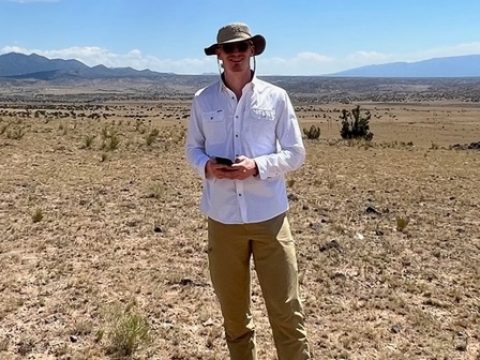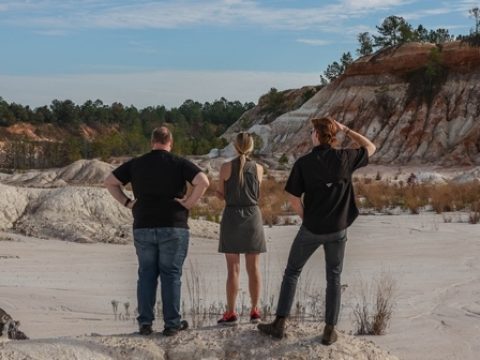Location Manager Ian Easterbrook
Securing Superman’s Most Iconic Sites
By Carol Badaracco Padgett
If you’ve sat in the cool darkness of the cinema lately and watched Clark Kent in action, maybe you spotted the name in the credits at the end. Location Manager Ian Easterbrook.
Easterbrook’s primary role in the film was to oversee the entire process of filming on location. It’s a huge undertaking—one that showcases just how much talent and collaborative effort exists among Georgia’s crew base and creatives.
Read on for some superfly anecdotes that Atlanta-based Easterbrook shared in a recent sit-down conversation.
How did the 2025 blockbuster film Superman become such a cool summertime calling card for Georgia filmmaking?
Easterbrook: It was just a massive undertaking and there was involvement from so many different people, both within our production and also tons of support outside from municipalities and vendors--just so much support from outside of our production to make something like this happen.
It was really cool to see Georgia so prominently featured on the big screen in such a really touching and human story, as part of a project that has generated so much excitement and interest not only in Georgia but around the world. The outpouring of support and love is really cool, and so is seeing Georgia play such a huge part of it.
I'm from the South and I've lived in Atlanta for well over a decade now. And I’ve spent most of my career based out of here. So it's really gratifying to see this come to life. As you know, for Superman we were based just south of the city at Trilith Studios for all of our pre-production and the work on stages. But we also had a number of very significant locations in the story that are here in Georgia, as well.
Of all the locations in the film, tell me about one of your absolute favorites.
Easterbrook: They're all pretty exciting, but one of the most exciting ones was Clark Kent's family home--the legendary and iconic Kent farmhouse. I worked closely with our location scout, Josh Dillard. He was tasked with finding that Kent farmhouse, among several other things. To be a part of finding such an iconic and recognizable location in this incredible story was an amazing opportunity.
My hat is off to Josh--he’s an incredible scout. We spent months looking for that farmhouse, and eventually Josh found the perfect one out in LaGrange, Georgia.
What’s the story behind this particular Georgia farmhouse?
Easterbrook: It was owned by a wonderful family and it was actually empty. It had been in the family for a long time, and their grandfather that lived there had passed away. It was a perfect opportunity to use this house that was so unique and so interesting to tell the story that James [Gunn] had written, and to deliver the creative vision of our wonderful production designer, Beth Mickle. It was perfect.
It sounds like the house and the filming of Superman that took place there really made a beautiful ode to the family’s grandfather who once lived there.
Easterbrook: That’s right. And when we were scouting out there, they had tons of land in the surrounding property, too, and it was still a very active farm with lots of cows.
I've got videos of some of the early [times] when we brought James out there along with the rest of the creative team and the VFX team. And we were all standing out there in this field surrounded by cows and we're trying to talk through the story. And you could hear these cows mooing in the background around us out of curiosity, just wondering, who are these people standing in the middle of our field?
Then the conversation became, okay, when we're filming here, what the heck are we going to do with all these cows? Which, you know, that ended up becoming sort of a running theme and a running conversation for the show--endless meetings and questions about what do we do with these cows.
I’ve got to ask, how did you handle the cows during filming at the farmhouse location?
Easterbrook: Well, we actually worked really closely with the family that owned the property. They’re farmers and they work with these cows. Our priority was filming there as safely and efficiently as possible, and to preserve this for the cows--their day-to-day routine and trying not to disrupt them. So, what we did was relocate them to adjacent fields and bring in a water source for them in the new field.
We basically danced the cows around so that when we were filming over here, we would just put them over there for the day, This is so funny, because the field that we put them in, next to the field where we were filming, didn’t have much shade. So we actually put up a bunch of pop-up tents for the cows to hang out underneath. I've got pictures of these cows hanging out under the pop-up tents, like you see when you go on a film set--usually with humans under them and a bunch of gear and equipment.
I've been doing this for something like 13 or 14 years now, and I will say, I've never put up pop-up tents for cows until Superman.

You mentioned how managing film locations is about preserving the locations you choose to use and working with the people who live there. What was your relationship like with the family that owned the property that became the Kent farmhouse?
Easterbrook: The owners of the property were just a delight to work with. And to see that sort of passion and excitement from them was fabulous, because they were Superman fans and their property got to be in the movie. So, to see them and have their support all the way through the months of preparation was just incredible. You really can't ask for anything more as a location manager than to have a location owner who just totally buys into the experience of filming and wants to be a part of it.
At the end of the day, it really does take a team. We have our team of people in the locations department and our team of people on the production, but to get it done successfully, everybody has to become a part of the team--and that includes the people that own the locations where you're filming, as well as the representatives from the municipality and its government, along with the vendors that you're dealing with.
It’s our job in locations to bring everybody onto the team and to create this supportive environment where everybody is moving towards the same goal. The family who owned what became the Kent farmhouse was able to come out and join us for filming and watch this iconic story being told right there on their farm. It was amazing.
Let’s shift over to Macon, Georgia. Tell us about the absolutely incredible location for the Daily Planet newspaper, where Clark works as a reporter.
Easterbrook: All of the interior of the Daily Planet was filmed in Macon, Georgia at the historic bus terminal there. It’s kind of a strange story because we also had a considerable amount of locations working up in Cleveland, Ohio, and in Cincinnati. So, a lot of the exterior of Metropolis was in Ohio. But all of the interior work scenes take place inside the Daily Planet, in Macon.
There was a lot of conversation about how to address all this work there, because at one point we had considered building the entire Daily Planet on a stage and shooting it there. We also thought about finding an interior up in Ohio, since the exterior was up there in Cleveland. But we just couldn't find the right building. So, Josh [Dillard] and I were talking about it one day, and Josh was like, hey, what about the bus terminal down in Macon? It's got some art deco elements to it that could kind of work and we looked at some photos and then showed them to Beth [Mickle], our production designer, and took her down there to see it. And she's like, actually, I think we can make this work.
What did it take to get the bus terminal to look like the news offices of the Daily Planet?
Easterbrook: The Macon bus terminal on its own is empty and completely stunning--it's beautiful. In the building, there are original wood benches. They’re amazing curved, wooden benches that are original to the building. It’s where all the passengers would hang out waiting to board.
As we were trying to plan out how to make this the Daily Planet, we had all these round benches in the middle and we're figuring out, okay, are we going to have to take these things out before we dress the Daily Planet in here, because the benches kind of took over the space.
We reached out to some historical preservation companies and restoration companies about what it was going to take to remove these benches, because we didn’t want to damage them. We wanted them to go back the way they were. I think it was Beth [Mickle] who had the idea to just incorporate them into the design of the Daily Planet. And so, if you look in the movie, all of the desks for the Daily Planet were built over the existing benches in the bus terminal in Macon. So, literally, she designed the whole set around the way the benches and the building exist currently, and just built over and around it and incorporated it into the set.
So, when Clark turns around in his desk chair to talk to Lois and Jimmy, all of those desks were literally shelves built over the top of the existing benches,
Tell us about one last iconic Superman location--the battle scene with the tanks. Where was the location and how did you choose it?
Easterbrook: This seemingly remote, alien-looking kind of desert location was actually filmed at a sand mine right down in Roberta, Georgia, just a couple hours south of Atlanta.
You step out into this place, this abandoned sand mine, and you feel like you're on a different planet. And what's cool is that we scouted all over the place, and not only all over Georgia. We were even out in New Mexico looking for locations for that scene. And we found some amazing locations there, some really, really cool stuff.
Ultimately, though, it was just tough to beat the location that we had right here in Georgia, where we were close to everything else for our production.
